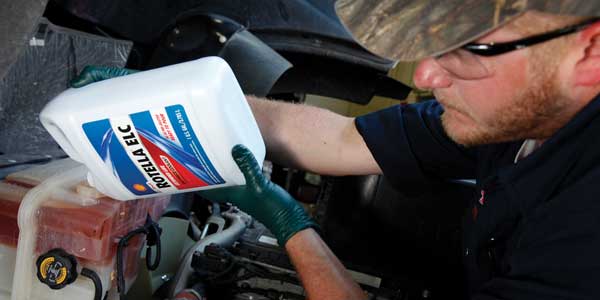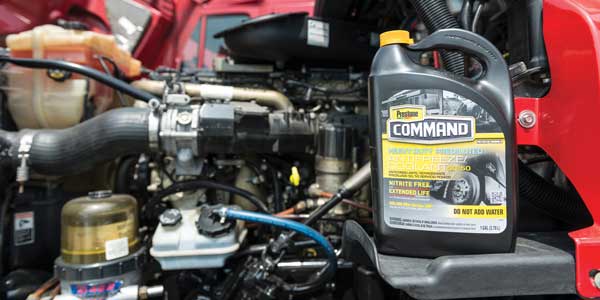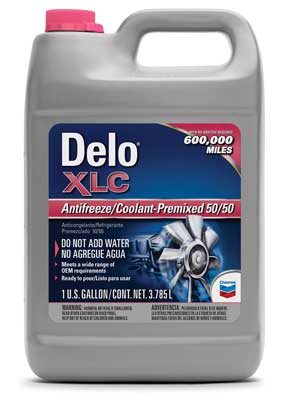Extended life coolant (ELC) is the coolant of choice for the many over-the-road long-haul fleets today. As engine OEMs churn out improved efficiency and fleets battle for lower cost per mile, it just makes sense. Flushing the coolant is a time-consuming process and your clients aren’t paying for downtime. That said, it’s not a fill-it-and-forget-it process. The chemistry of today’s extended life coolants is complex, and it’s important that you are maintaining the proper mix to ensure that you’re making the most of the “extended life” and cutting its coolant lifespan short.
Let’s say that you’re running an ELC and coolant gets topped off, as coolant tends to do, but your techs aren’t topping off with ELC—they’re topping off with a non-ELC. One top off could mean that the inhibitor package built into the ELC is now diluted by 5%. After four top-offs with the incorrect coolant, your ELC coolant could be diluted past the point of extended-life effectiveness.
“You want to keep the old-style, conventional, silicated, fully formulated—the purple coolants—separate from the extended life coolants. They are completely different additive technology,” said Stede Granger, OEM technical manager for Shell Lubricants. “If they are mixed, you’re diluting the effectiveness of each additive, and you may end up in a situation in which you don’t have enough corrosion protection in the cooling system.”
For its coolants, Shell requires the coolant within the truck to retain 75% to 80% of its additive technology. Once it dips below that range, Shell Lubricants recommends that corrective action be taken to bring the additive level back to normal levels. Test strips are available for testing Shell Rotella ELC coolants to see that they have the correct additive level.
“Chevron requires for its coolants is at least 75% of our inhibitor package in there to give the protection you need for your engine,” clarified Dan Holdmeyer, industrial and coolants brands manager at Chevron. “If you get below that, then you don’t know what kind of protection you’re getting, whether you’re going to get the conventional coolant, the different carboxylates versus what ours are; so, if you don’t have at least 75% in there, we don’t feel like we can give you the protection you need.”
If you’re tackling all of your own maintenance, keeping coolants straight in shop can be as simple as ensuring that your maintenance shop is carrying the proper coolants and training technicians correctly. There are bigger question marks when it comes to outsourced service and drivers topping coolant off. Let’s start with the former.
“There ought to be a discussion between the fleet and the service provider about what type of coolant they’re using and what kind of coolant they wanted added to their system. I wouldn’t assume that the shop will know,” Granger said. “I recommend that if you’re using a known coolant such as Shell Rotella ELC nitrite-free, you want your contract maintenance provider to absolutely, positively know that you’re running that coolant, and any coolant system work or any top off would us Shell Rotella ELC nitrite-free.
“Why mix chemistry when you don’t have to?”
It’s a valid question. It’s extremely important for your service provider to know that you run ELC, regardless of brand. It’s also important for your drivers to know, or at least arm them with coolant.
“It’s always wise to send your drivers on the road with several gallons of your approved coolant,” said Colin Dilley, Prestone’s vice president of technology. “We strongly advise fleet managers to consistently use the same high-quality coolant for all their vehicles. With nationally known, high-quality brands, you significantly minimize the potentially significant issues that come with discount or recycled product. Emergency, on-the-road purchases can cost more and contaminate an otherwise well running system.”
How do you really know?
The only way to know is to test.
“If you could have a truck factory filled with extended life coolant and you could lock up the cooling system, and assuming it was a dry system, it didn’t leak anything, you really wouldn’t have to check it, right?” Granger said with a laugh. “But that’s not the real world. In the real world, stuff happens. The big question is if the trucks get out of your control or not.”
The first test Granger recommended was testing the freeze protection. That might seem like a strange test to start with as summer temperatures start boiling the mercury, but it’s a common misconception that you don’t need to check the freeze protection mix in the summer. In days past, some fleets might have topped off with water, but that effectively raises the freezing point and dilutes the additives. It’s worth repeating: Testing the freeze protection is just important in July as it is in January to ensure you get the freeze protection you expect when the temperature drops.
From there, do a tried-and-true visual inspection to check for leaks and ensure that nothing has contaminated the coolant. Oil leaking into the coolant system is a maintenance headache, but also needs to be diagnosed and dealt with swiftly.
After that, major coolant suppliers offer a test kit that will take the temperature of the proprietary additives within the coolant.
“Prestone has a complete line of testing strips available as well as a professional grade DEF/EG refractometer,” Dilley said. “We recommend always testing your water quality with our water quality test strips to make sure your water isn’t too hard or soft and that the pH level is appropriate. Then you can use or IAT (SCA) coolant test strips or ELC [NOAT, OAT] test strips to make sure your inhibitor protection is adequate. Lastly, our refractometer can make sure your ethylene glycol concentration is correct, as that ensures both freeze point and boiling point are correct to keep your engine running.”
While you can typically use test kit across brands, keep in mind that the test kits are specifically designed to detect that brand’s chemical makeup. Using a Shell test kit on Chevron or Prestone coolant (or vice versa), for example, can lead to unreliable results. When in doubt, use the test kit provided by your coolant supplier.
“We saw some that worked and some that didn’t,” Shell’s Granger said. “Here’s the thing: Let’s say you bought a truck used. It had somebody else’s extended life coolant in there, then you top it off with some Shell and it fails the test. Then you say that where you bought the truck from was maintaining the extended life coolant in; we get the question, ‘Why is this truck failing the test?’ Well, it could have some chemistry that doesn’t trip our test strip.”
“It’s very similar to what you have with your engine oils—stick with one,” Chevron’s Holdmeyer said. “In the additive chemistry of the coolants, most of them are compatible with each other. You’re most likely not going to have additive dropout, and you’ll have protect, but how much? Will protect your system the way you expect with ELC? Just topping off with anything willy-nilly is not a good idea.”
Can I switch to ELC?
So, you want to change over to ELC? Congrats! You’ll reap the benefits, as long as you maintain the right mix. Sure, you could flush your coolant system and replace it with ELC, but there’s no guarantee that you’ll get all of the old coolant out of all hose nooks and crannies. That’s not to say it’s impossible, you just have to keep an eye on the chemistry. First, check for stability and concentration levels within the existing coolant. Then you need to check the pH because as coolants age and deteriorate, they form acids much like oils do. They break down and form acids.
“If you have too low of a pH, then you need to get rid of it,” Holdmeyer said. “If you know you’re dealing with a conventional coolant [a non-extended life coolant] and you’ve had it in there for 200,000-plus miles, and you’ve been doing the supplemental coolant additives, there’s a good chance you have an old dissolved solids level that’s too high, and that’s not good. You need to get that out of there, but you should get that out of the system routinely with conventional coolants. We would then just drain the system and put in a fresh charge of our extended life coolant.”
There is, however, an easier a way. Chevron, for example, offers FleetFix EMX nitrite free and FleetFix CME. It’s a concentrated dosage of the carboxylate and inhibitor package that is put into a coolant system.
“If you follow the procedure properly, we can utilize that to do a conversion from conventional coolant over to Delo ELC,” Holdmeyer said. “It’s also there to give you maintenance, so if you do get below that 75%, we can boost it up, or if you’re looking to go to over a million miles or something like that, then you use it as an extender.”
Again, stick to your coolant brand of choice if you’re changing over.
“We developed the FleetFix CME or the FleetFix EMX to work specifically with our coolants because we know we have different types of inhibitors in there, the organic inhibitors in there,” Holdmeyer said.
If you’re using Shell coolants, keep an eye out for Shell ELC Correction Fluid, which can also be used for the conversion process, as well as top-offs to ensure that you’re keeping the right mix of additives within the coolant.
Too much of a good thing?
Given all the talk of proper coolant mixes, the next logical question is: Are there adverse effects from having a coolant that is too additive concentrated?
The short answer is no. The long answer, as Shell’s Granger explained, is that there haven’t been any observable impacts. In fact, none of Shell’s internal studies have shown any negative effects.
“We went up to 300% or 400% concentrated,” Granger recalled. “Obviously, the negative is extra cost. We believe the additive level we have is the right level, the optimal level, but right now we’re not seeing any negatives from going up too high a concentration.”
That doesn’t mean you can go crazy with your additives. Prestone’s Dilley noted that “whenever you are adding additives to the coolant you can negatively affect the ability to maintain freeze point, as more additives means less ethylene glycol, less freeze point and boil-over protection.”
When it comes down to it, the best coolant solution is to know what’s in your mix.
















